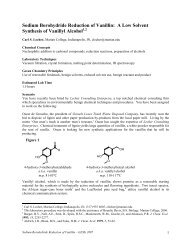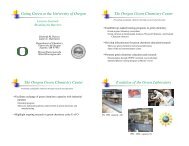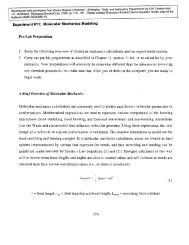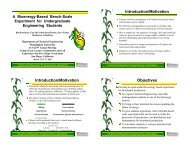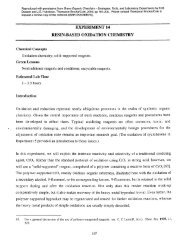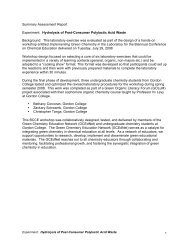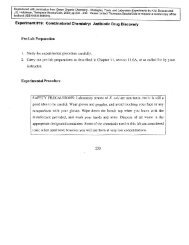Simple Distillation: Purification and Reuse of Acetone Great ...
Simple Distillation: Purification and Reuse of Acetone Great ...
Simple Distillation: Purification and Reuse of Acetone Great ...
Create successful ePaper yourself
Turn your PDF publications into a flip-book with our unique Google optimized e-Paper software.
<strong>Simple</strong> <strong>Distillation</strong>: <strong>Purification</strong> <strong>and</strong> <strong>Reuse</strong> <strong>of</strong> <strong>Acetone</strong><br />
Carl S. Lecher, Marian College, Indianapolis, IN, clecher@marian.edu<br />
Chemical Concepts / Green Lessons<br />
<strong>Distillation</strong>, solvent recycling, boiling point determination<br />
Estimated Lab Time<br />
1.5 – 2 hours<br />
Scenario<br />
The following letter was sent to Lecher Consulting Enterprises from Mary St<strong>and</strong>ards.<br />
<strong>Great</strong> American Paint Company<br />
123 U.S.A. Parkway<br />
Freedom, IN 47240<br />
Dear Dr. Lecher,<br />
My name is Mary St<strong>and</strong>ards <strong>and</strong> I am the Vice President <strong>of</strong> Operations at the <strong>Great</strong> American<br />
Paint Company. I am looking for technical assistance with a proposal which may be <strong>of</strong> great<br />
value to our company.<br />
At the <strong>Great</strong> American Paint Company, our focus is on making high quality paints at reasonable<br />
prices. For the last several years, we have been using acetone to clean the inside <strong>of</strong> our<br />
processing equipment between batches <strong>of</strong> different colored paint. After the acetone is used, it<br />
is contaminated with paint <strong>and</strong> must be collected <strong>and</strong> drummed. For the last several years we<br />
have been using AAA Disposal Company to pick up our acetone waste <strong>and</strong> dispose <strong>of</strong> it in<br />
accordance with state <strong>and</strong> federal regulations. The cost <strong>of</strong> the disposal service has risen<br />
dramatically over the past five years. However, we have been unable to raise the price <strong>of</strong> our<br />
paint products to <strong>of</strong>fset these increased production costs due to stiff competition from foreign<br />
paint products that do not face the same environmental regulations that we face here in the<br />
United States.<br />
It was recently brought to my attention that it may be possible to devise a procedure to recycle<br />
paint-contaminated acetone. I am asking you to propose a method <strong>of</strong> recycling the acetone, to<br />
demonstrate the method on a small scale, <strong>and</strong> then to demonstrate that the recycled acetone<br />
will be <strong>of</strong> sufficient quality to be reused.<br />
Sincerely,<br />
Mary St<strong>and</strong>ards<br />
Mary St<strong>and</strong>ards<br />
Vice President <strong>of</strong> Operations<br />
<strong>Simple</strong> <strong>Distillation</strong> – GEMs 2007 1
Lecher Consulting Enterprises is a top notched chemical consulting firm which specializes in<br />
environmentally benign chemical techniques <strong>and</strong> procedures. You have recently been hired by Lecher<br />
Consulting Enterprises <strong>and</strong> have been assigned to work on the problem outlined in the attached letter.<br />
Background<br />
The process <strong>of</strong> vaporizing a liquid mixture in one vessel <strong>and</strong> condensing the vapors into another vessel is<br />
called distillation. The liquid being distilled is heated in a flask, which is sometimes called a distillation<br />
flask or distillation pot. The vapors are condensed on a cool surface, usually a water-cooled condenser.<br />
The resulting liquid is called the distillate <strong>and</strong> is collected in a receiving flask.<br />
A vaporization-condensation cycle is when a substance vaporizes <strong>and</strong> condenses one time. A simple<br />
distillation involves only one vaporization-condensation cycle. <strong>Purification</strong> occurs as the volatile liquid<br />
vaporizes <strong>and</strong> leaves behind the nonvolatile (or less volatile) impurity. <strong>Purification</strong> by simple distillation is<br />
appropriate for liquids that contain either nonvolatile impurities, or very high boiling point impurities.<br />
When a liquid contains an impurity with a boiling point close to its own (~25°C), then fractional<br />
distillation, which involves multiple vaporization-condensation cycles, would be required to separate the<br />
two substances.<br />
thermometer adapter<br />
blue clip<br />
to drain<br />
cold water in<br />
West Condenser<br />
100 mL round bottom flask<br />
blue clip<br />
distilling adapter<br />
6 5<br />
7<br />
4<br />
8<br />
3<br />
9<br />
2<br />
10 1<br />
6 5<br />
7<br />
4<br />
8<br />
3<br />
9<br />
2<br />
11 1<br />
Thermowell heat source<br />
Stir plate 50 mL receiving flask<br />
blue clip<br />
receiver support<br />
Power Mite heat controller<br />
Figure 1. <strong>Distillation</strong> Apparatus<br />
<strong>Simple</strong> <strong>Distillation</strong> – GEMs 2007 2
Safety Precautions<br />
<strong>Acetone</strong>: <strong>Acetone</strong> is volatile <strong>and</strong> flammable; avoid open flames.<br />
Experimental Procedure<br />
<strong>Distillation</strong> <strong>of</strong> <strong>Acetone</strong><br />
1. Assemble the apparatus as depicted in Figure 1 as follows:<br />
a. Set up ring st<strong>and</strong> <strong>and</strong> stir plate.<br />
b. Make sure that the Thermowell is plugged into the variable heat controller. ALWAYS use a<br />
variable heat controller with your Thermowell. Never plug the Thermowell heater directly<br />
into an electrical socket!<br />
c. Clamp a 100 mL round bottom flask (always check glassware for cracks) into the bowl <strong>of</strong> the<br />
Thermowell. The flask should be immobile.<br />
d. Add approximately 40 mL <strong>of</strong> contaminated acetone via a funnel.<br />
e. Add a stir bar.<br />
f. Attach a three way adapter.<br />
g. Attach a thermometer adapter.<br />
h. Carefully insert thermometer so that the bulb is slightly below the side arm <strong>of</strong> the three way<br />
adapter.<br />
i. Using a blue clip, attach the West condenser so the jacket inlet / outlets are pointed up.<br />
j. Attach the distilling adapter, securing it the West condenser with a blue clip.<br />
k. Attach a 50 mL round bottom flask to the distilling adapter with a blue clip. If the 50 mL<br />
round bottom flask does not rest on the bench top, use an appropriate size <strong>of</strong> beaker to support<br />
the receiving flask.<br />
l. Attach water hoses as depicted. Note that the condenser water should flow in the lower end <strong>of</strong><br />
the condenser <strong>and</strong> out the upper end.<br />
m. Turn on the condenser water supply to provide a gentle but steady stream <strong>of</strong> cooling water.<br />
n. Have your apparatus checked by the instructor before beginning to heat.<br />
2. Begin stirring <strong>and</strong> turn on the heat source to achieve a gentle boil. Start the stirrer <strong>and</strong> turn on the<br />
heat source (~30% power). Adjust heat source so that the liquid boils gently <strong>and</strong> the reflux ring <strong>of</strong><br />
condensing vapors rises slowly into the still head. Shortly after the reflux ring reaches the<br />
thermometer bulb, the temperature reading should rise rapidly <strong>and</strong> vapors should begin passing<br />
through the sidearm into the condenser, coalescing into droplets that run into the receiving flask.<br />
As the first few droplets come over, the thermometer reading should rise to an equilibrium value<br />
<strong>and</strong> stabilize at that value. At this time, the entire thermometer bulb should be bathed in<br />
condensing liquid, which drips <strong>of</strong>f the end <strong>of</strong> the bulb into the pot.<br />
3. Record the temperature at which the thermometer reading stabilizes; if it is lower than expected,<br />
recheck the thermometer placement.<br />
4. If the initial thermometer reading is within the expected boiling range, skip to the next step. If the<br />
initial thermometer reading is below the expected boiling range, then continue the distillation until<br />
the lower end <strong>of</strong> the range is reached, collecting the forerun in the receiver, <strong>and</strong> then replace the<br />
receiver by another one. Try to make the switch quickly enough so that no distillate is lost.<br />
5. Distill the liquid at a rate <strong>of</strong> about 1 to 3 drops per second, monitoring the temperature frequently<br />
throughout the distillation. Distil until one <strong>of</strong> the following occurs:<br />
a. the receiving flask is 75% full,<br />
b. or until about 5 mL <strong>of</strong> volume remains in the boiling flask,<br />
c. or the upper end <strong>of</strong> the expected boiling range is reached.<br />
<strong>Simple</strong> <strong>Distillation</strong> – GEMs 2007 3
6. Turn <strong>of</strong>f the heat source. Do not distil the boiling flask completely dry! Remove the heat source if<br />
necessary. Heating a dry flask will cause tar formation (or even an explosion!).<br />
7. Transfer the remaining pot residue to the container in the fume hood labeled POT RESIDUE.<br />
8. Clean the distillation flask with soap <strong>and</strong> water. The remaining glassware will already be clean<br />
from the distillation <strong>of</strong> the acetone.<br />
Verification <strong>of</strong> Purity<br />
9. Verify the purity <strong>of</strong> your acetone by utilizing two separate techniques which you deem to be<br />
appropriate. Review the course Operating Procedures for student procedures as well as for<br />
technique principles <strong>and</strong> applications<br />
Disposal <strong>and</strong> Recycling<br />
10. When you are satisfied with your purity data, place your purified acetone in the appropriate<br />
container in the fume hood labeled PURIFIED ACETONE. The acetone will be reused by the<br />
instructor.<br />
Assignment<br />
In addition to completing your laboratory notebook, type a business-style letter as a representative <strong>of</strong><br />
Lecher Consulting Enterprises to Mary St<strong>and</strong>ards <strong>of</strong> the <strong>Great</strong> American Paint Company. In your letter,<br />
address whether or not it is possible to recycle acetone. If so, propose your method <strong>of</strong> purification.<br />
Describe to her how your lab apparatus functions. You should specifically address how purification occurs<br />
(including what happens to the impurities). Additionally, you should address how the purity <strong>of</strong> the acetone<br />
was verified.<br />
Due:__________________________<br />
<strong>Simple</strong> <strong>Distillation</strong> – GEMs 2007 4




